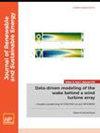Effect of an abrupt rough-to-smooth surface roughness transition on wind farm wakes: An LES and analytical modeling study
IF 1.9
4区 工程技术
Q4 ENERGY & FUELS
引用次数: 0
Abstract
Large-eddy simulations (LES) are performed on the flow over a wind farm sited behind an abrupt rough-to-smooth surface roughness jump. The change in surface roughness affects both the first-order and second-order turbulent statistics. The usual deficit, i.e., the difference between the velocities upstream of the entire wind farm and downstream of a turbine, attains negative values close to the ground, which makes it difficult for modeling within the usual Gaussian radial-shape framework. A different definition, i.e., the difference in velocity at the same location with and without a turbine on a heterogeneous surface, is always positive and is amenable to Gaussian shape-based modeling. For the setup considered here, wind farms sited downstream of a surface roughness jump produce more power than a wind farm sited on a homogeneously rough surface. This increase is primarily because of the larger power generated by the downstream turbines and only slightly due to the increased power of the first-row turbine. The farm performance is affected by the distance between the abrupt change in surface roughness and the position of the first row of turbines. The wind farm performance is also dependent on the aerodynamic roughness upstream of the surface roughness jump. Two single-turbine analytical models and three wake-merging strategies are evaluated for their ability to predict the velocity deficits. A corrected form of the standard Gaussian model with a recently proposed wake-merging methodology, applicable for a varying background field, is found to be insensitive to the tunable model parameter and is consistently in line with the LES results.粗糙到光滑表面粗糙度的突然转变对风电场波浪的影响:LES 和分析模型研究
对位于粗糙表面到光滑表面粗糙度突然跃变后的风电场上空的气流进行了大涡流模拟(LES)。表面粗糙度的变化会影响一阶和二阶湍流统计量。通常的赤字,即整个风场上游与涡轮机下游的速度之差,在接近地面时为负值,这使得在通常的高斯径向形状框架内建模变得困难。而不同的定义,即在异质表面上有涡轮机和没有涡轮机的同一位置上的速度差,总是正值,适合基于高斯形状的建模。就本文所考虑的设置而言,位于表面粗糙度跃迁下游的风电场比位于均匀粗糙表面的风电场产生更多的电能。功率增加的主要原因是下游涡轮机产生了更大的功率,只有第一排涡轮机的功率略有增加。风场性能受表面粗糙度突变与第一排涡轮机位置之间距离的影响。风场性能还取决于表面粗糙度跃变上游的空气动力粗糙度。对两个单涡轮机分析模型和三种尾流合并策略预测速度缺陷的能力进行了评估。结果发现,标准高斯模型的修正形式与最近提出的尾流合并方法适用于变化的背景场,对可调模型参数不敏感,并且与 LES 结果一致。
本文章由计算机程序翻译,如有差异,请以英文原文为准。
求助全文
约1分钟内获得全文
求助全文
来源期刊

Journal of Renewable and Sustainable Energy
ENERGY & FUELS-ENERGY & FUELS
CiteScore
4.30
自引率
12.00%
发文量
122
审稿时长
4.2 months
期刊介绍:
The Journal of Renewable and Sustainable Energy (JRSE) is an interdisciplinary, peer-reviewed journal covering all areas of renewable and sustainable energy relevant to the physical science and engineering communities. The interdisciplinary approach of the publication ensures that the editors draw from researchers worldwide in a diverse range of fields.
Topics covered include:
Renewable energy economics and policy
Renewable energy resource assessment
Solar energy: photovoltaics, solar thermal energy, solar energy for fuels
Wind energy: wind farms, rotors and blades, on- and offshore wind conditions, aerodynamics, fluid dynamics
Bioenergy: biofuels, biomass conversion, artificial photosynthesis
Distributed energy generation: rooftop PV, distributed fuel cells, distributed wind, micro-hydrogen power generation
Power distribution & systems modeling: power electronics and controls, smart grid
Energy efficient buildings: smart windows, PV, wind, power management
Energy conversion: flexoelectric, piezoelectric, thermoelectric, other technologies
Energy storage: batteries, supercapacitors, hydrogen storage, other fuels
Fuel cells: proton exchange membrane cells, solid oxide cells, hybrid fuel cells, other
Marine and hydroelectric energy: dams, tides, waves, other
Transportation: alternative vehicle technologies, plug-in technologies, other
Geothermal energy
 求助内容:
求助内容: 应助结果提醒方式:
应助结果提醒方式:


